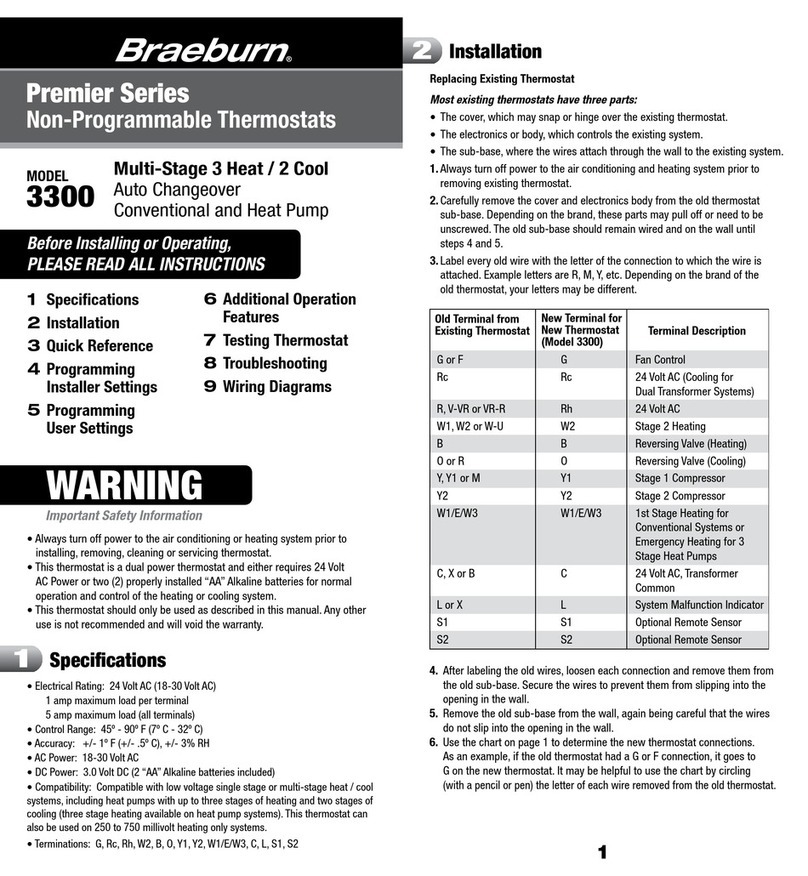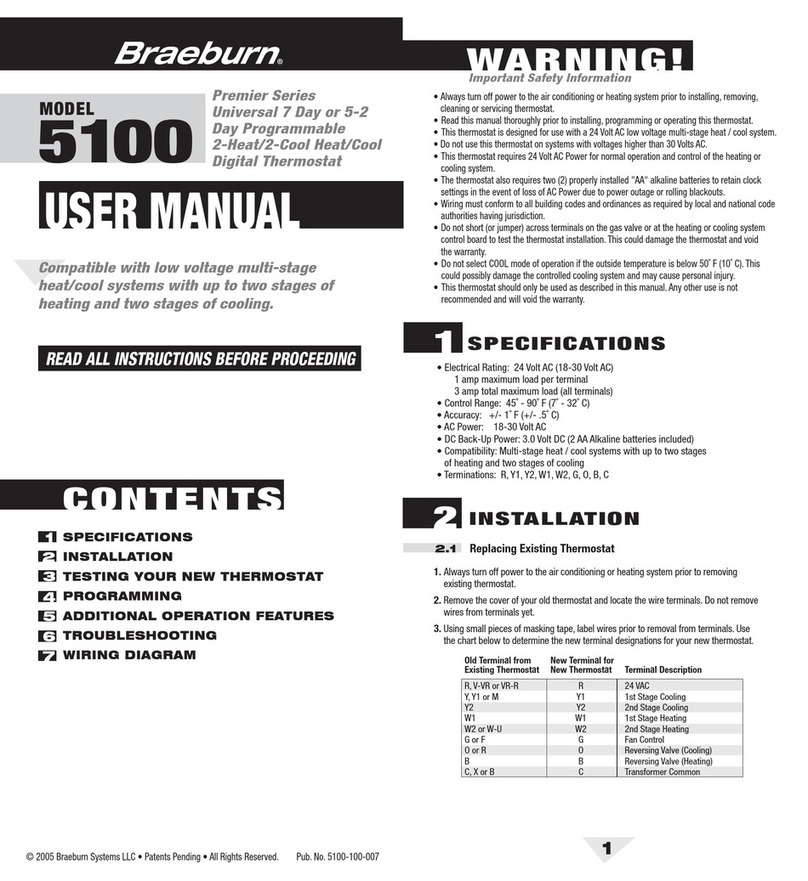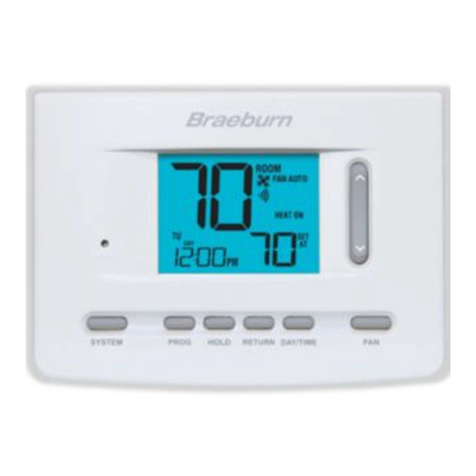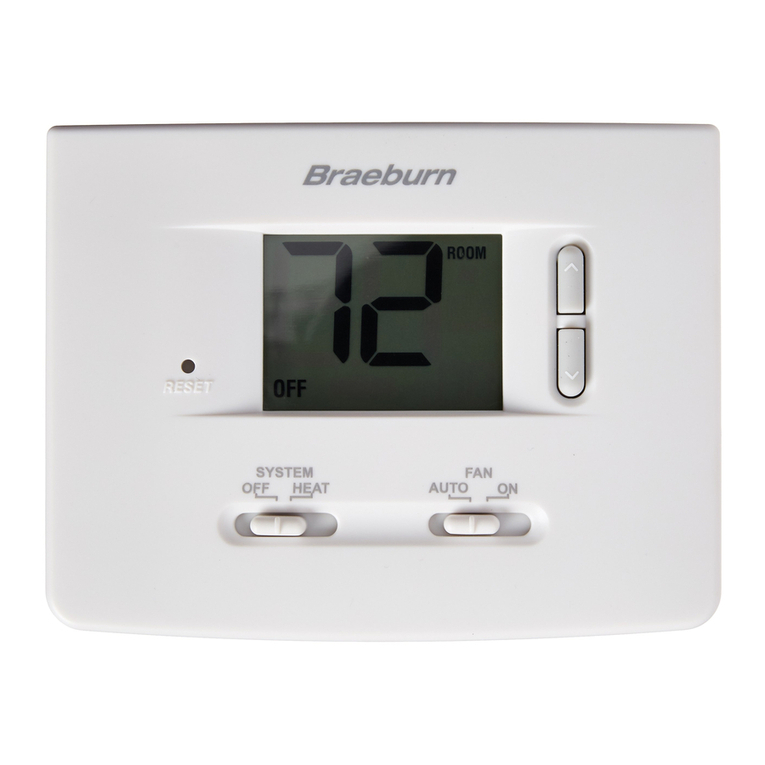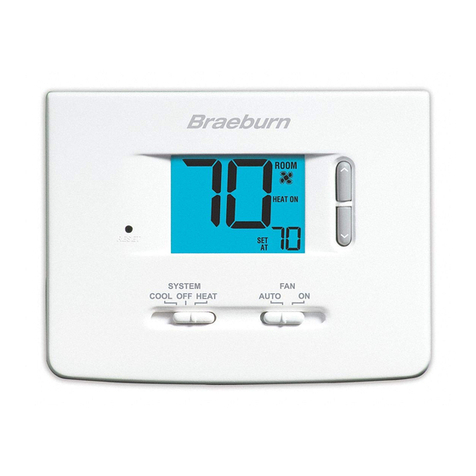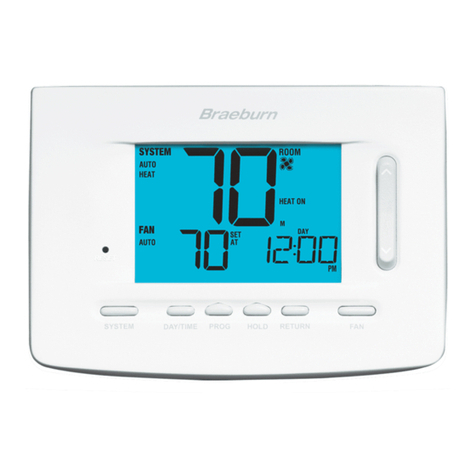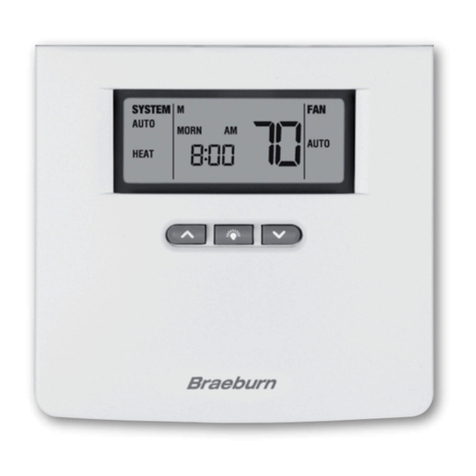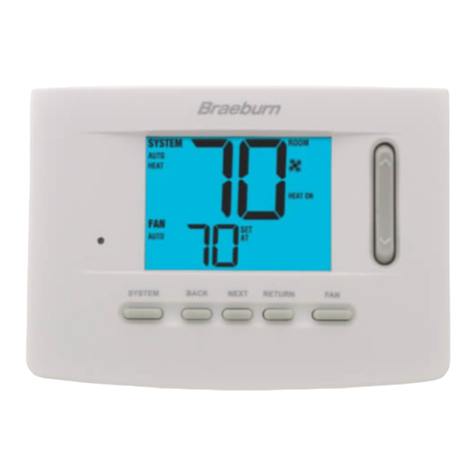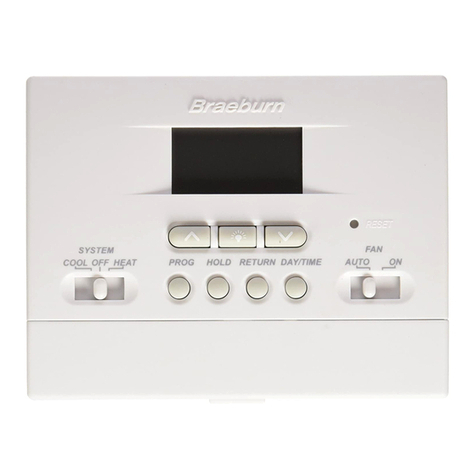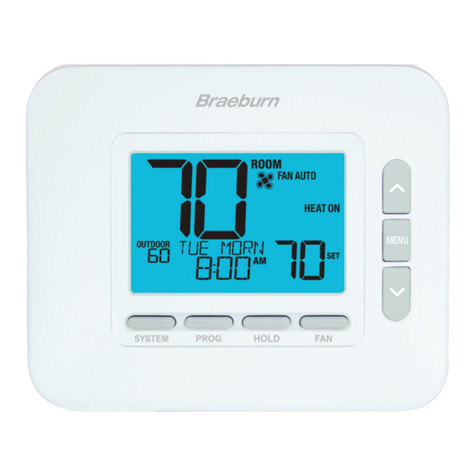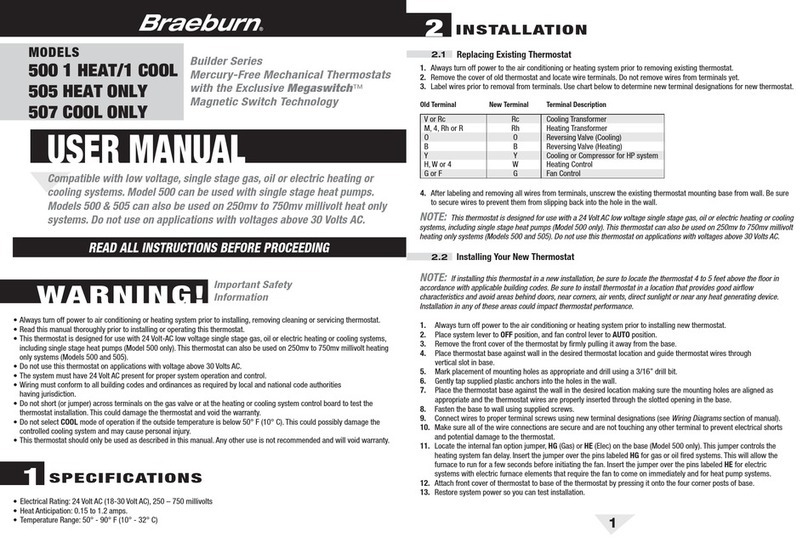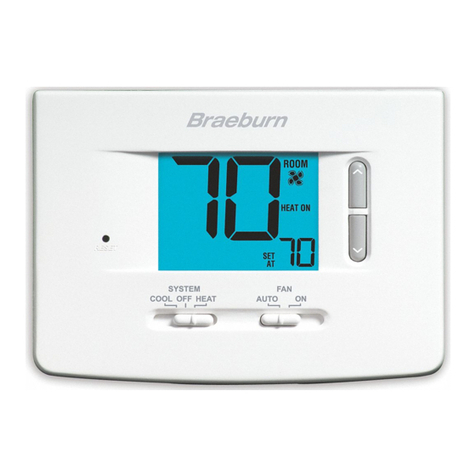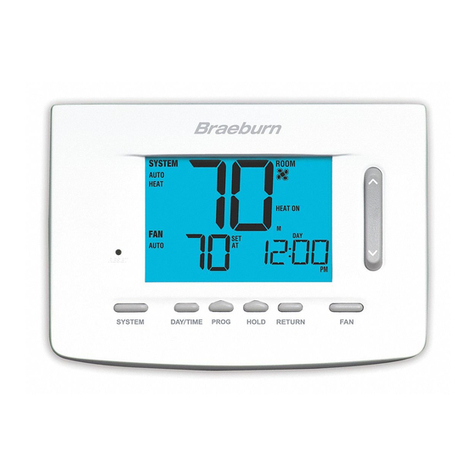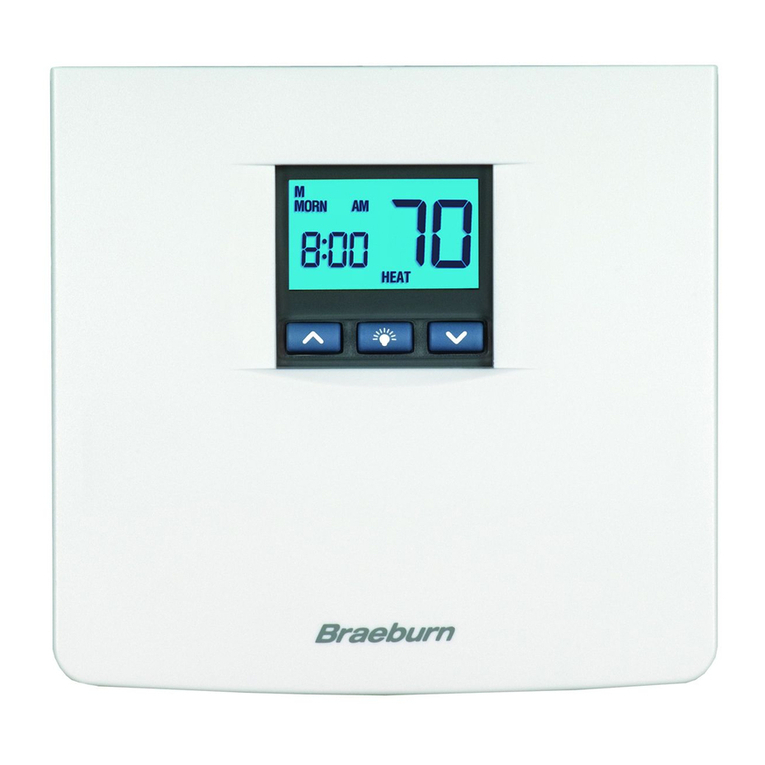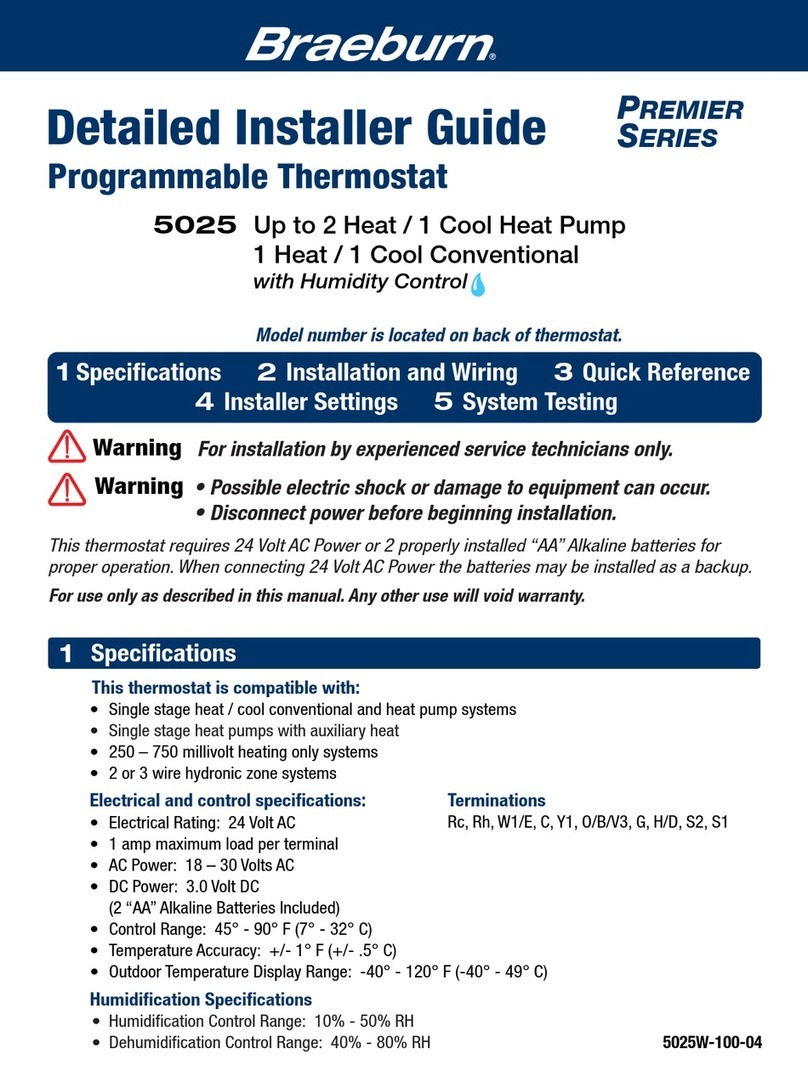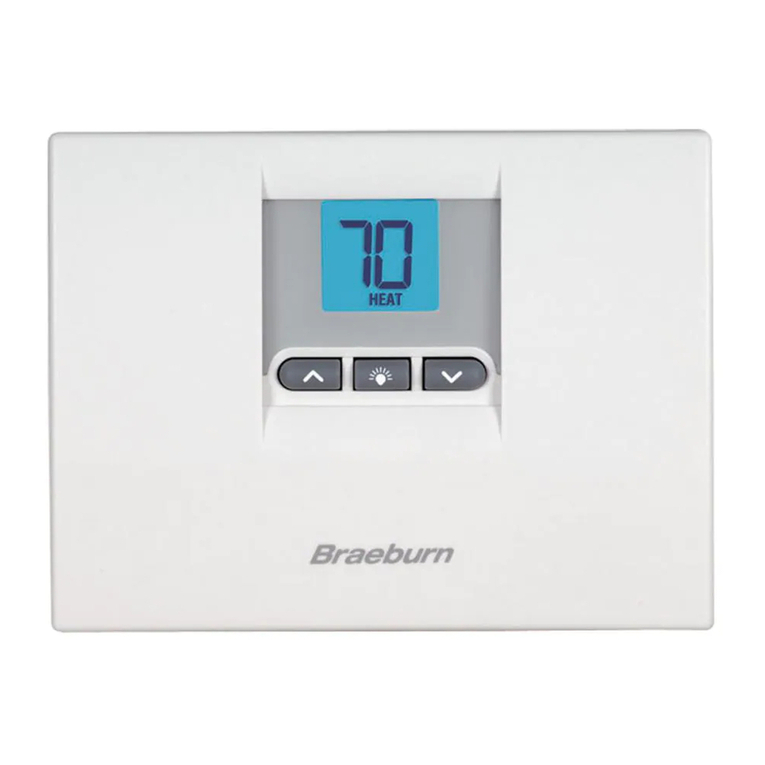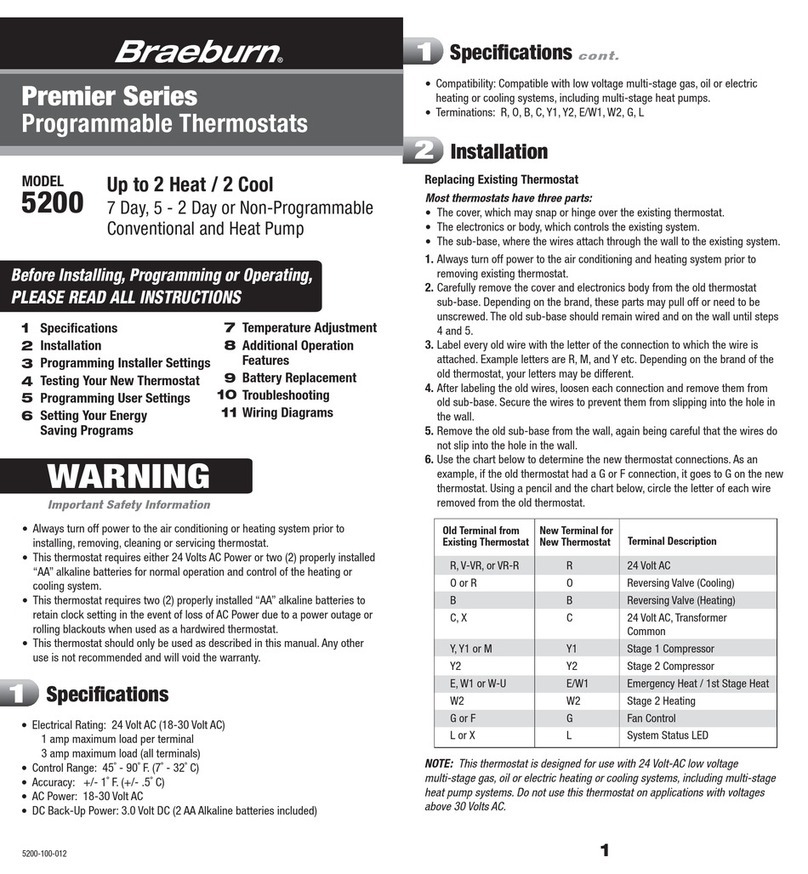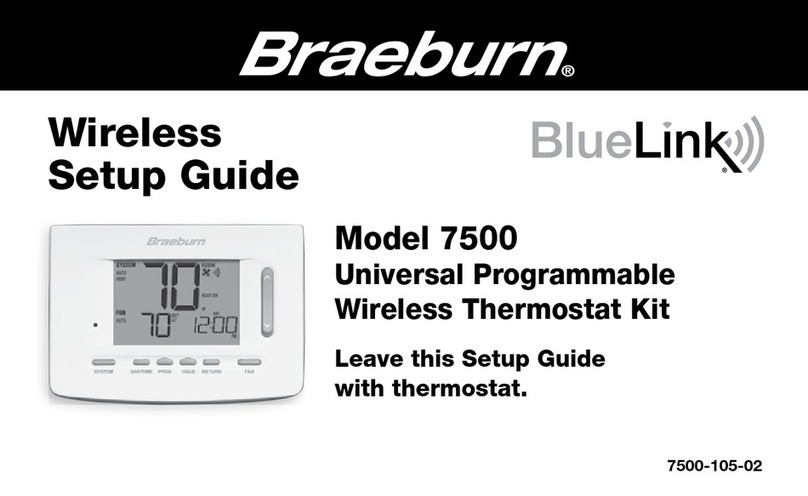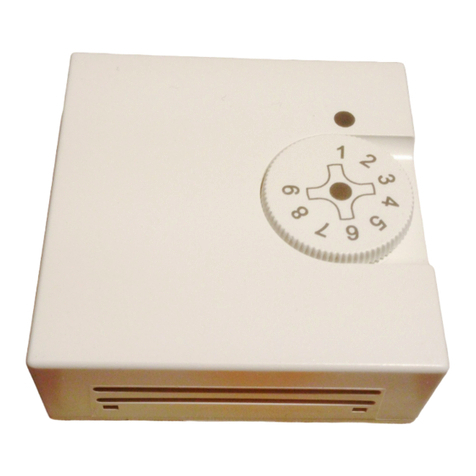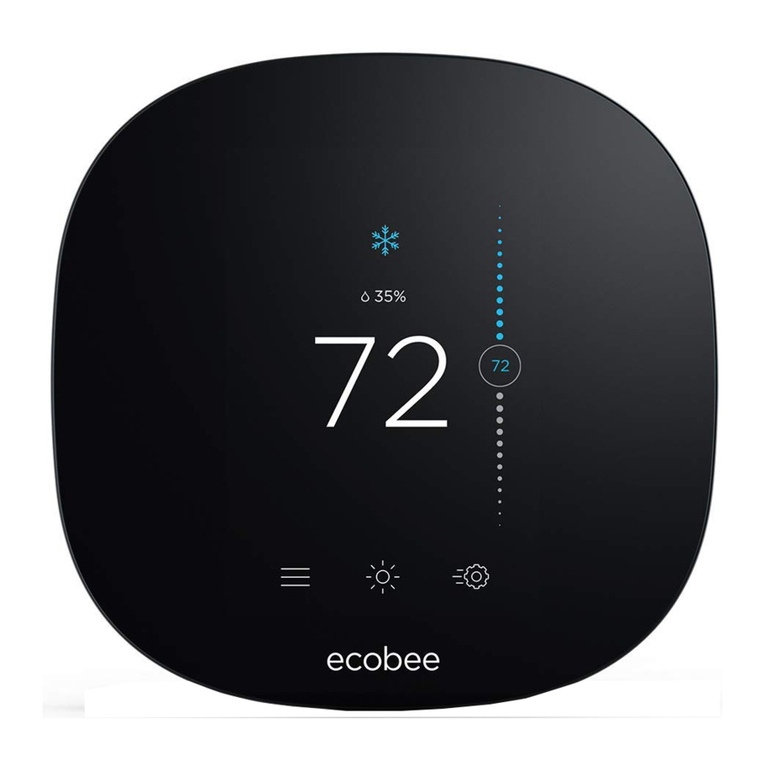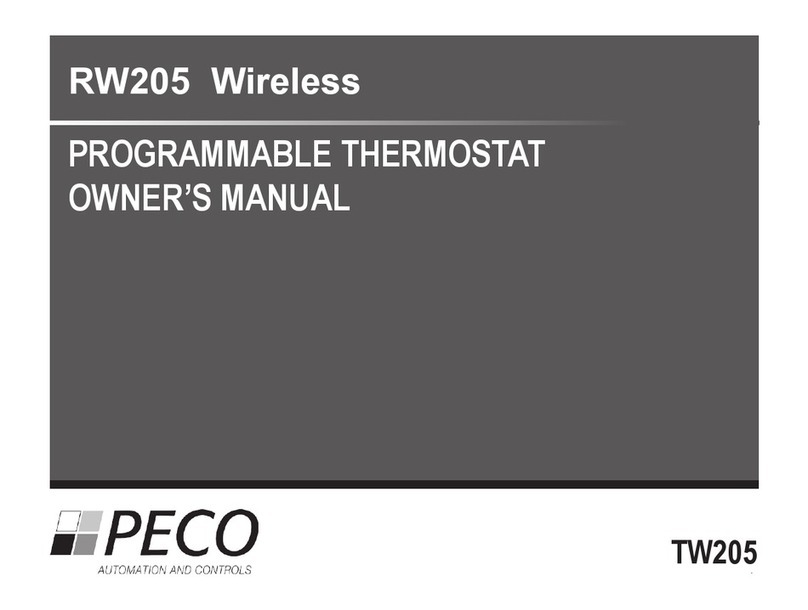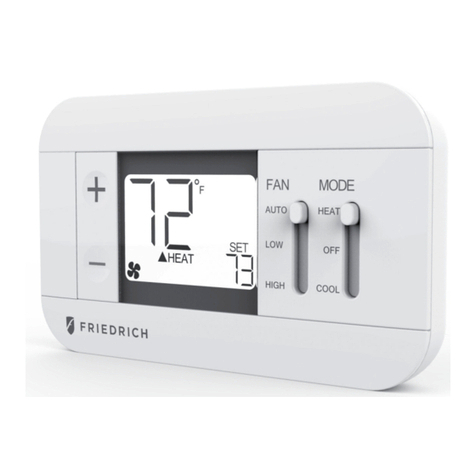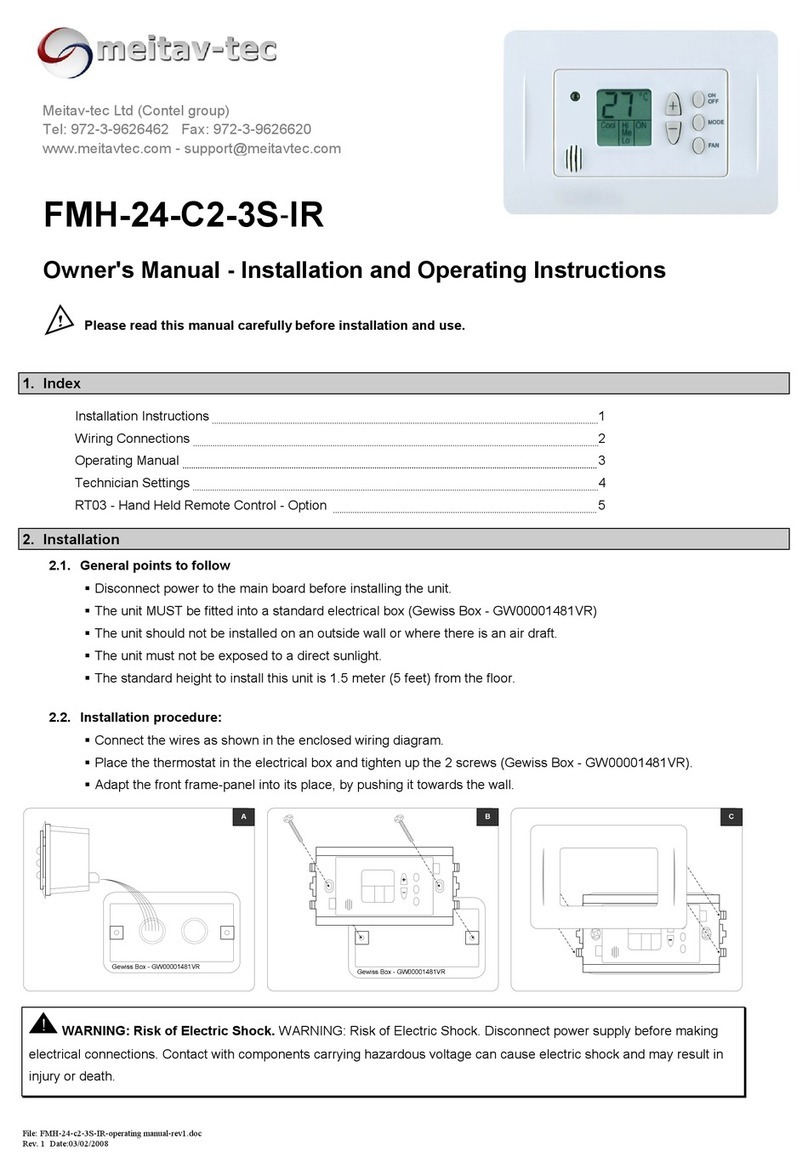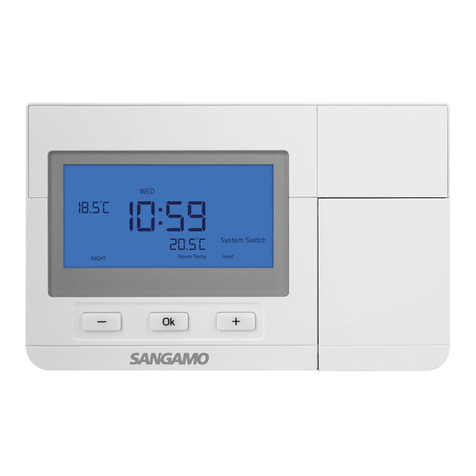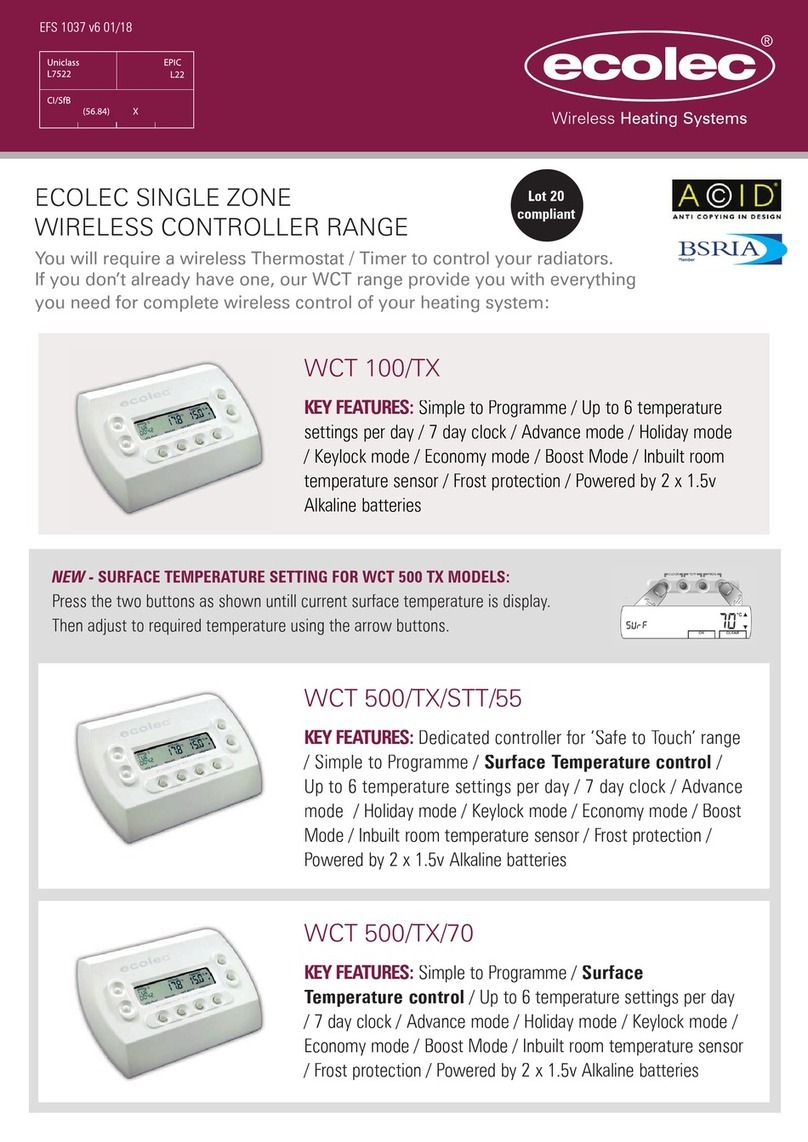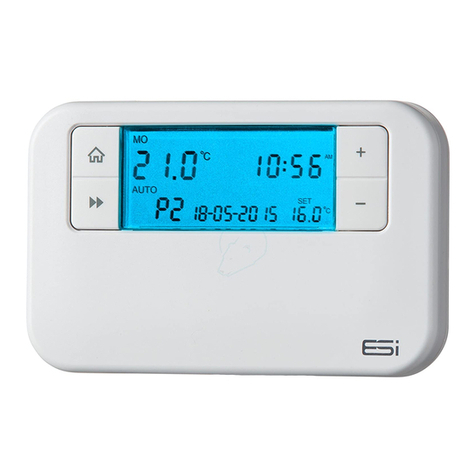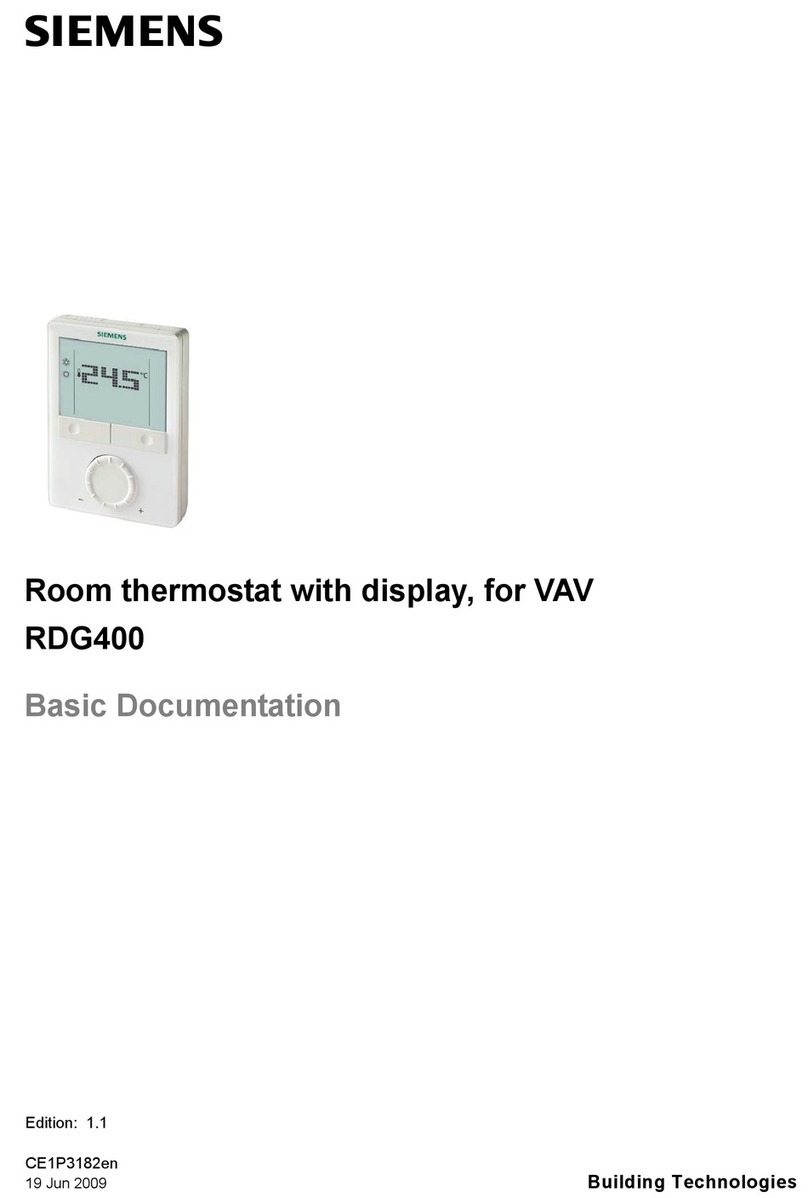4
INSTALLATION
3
10.
Fasten the rear body (mounting plate) to wall using supplied screws.
11.
Connect wires to quick wiring terminal block as appropriate using the new terminal
designations. Refer to Wiring Diagram section of this manual if required for assistance.
12.
Make sure all of the wire connections are secure and are not touching any other
terminal to prevent electrical shorts and potential damage to the thermostat.
13.
Turn the front thermostat body over exposing the rear view of the circuit board.
14.
Locate the internal fan option switch, HG (Gas) /
HE
(Elec) on the circuit board. This
switch controls the heating system fan delay. Select gas for gas or oil fired systems.
This will allow the furnace to run for a few seconds before intiating the fan. Select
electric for systems with electric furnace elements that require the fan to come on
immediately.
15.
Using your fingers, gently flip the switch towards the HG (gas) or H E (Elec) selection
which indicates the low voltage heating system the thermostat will control.
16.
Attach front body of thermostat to rear body of thermostat being careful to align the
terminal pins on the front body with the terminal block on the rear body.
17.
Restore system power so you can test installation.
3.2 Installing Your New Thermostat cont.
TESTING YOUR
NEW THERMOSTAT
4
NOTE: Test your thermostat prior to programming any user settings. Pressing the
RESET button will erase any user entries previously programmed. This will erase all
user settings and return them to their default values.
WARNING!
Read BEFORE Testing
1. Place the system switch in the HEAT position.
2. Press the button on the keypad until the setpoint temperature setting is a minimum of 3 degrees
higher than the current room temperature. The heating system should start within several
seconds. The fan may not turn on immediately due to the heating system built-in fan delay.
3. Place the system switch in the OFF position. The heating system should stop within several
seconds.
4. Wait 5 minutes for the automatic compressor short cycle protection period to expire, or press the
RESET button to bypass this feature for initial testing purposes. Pressing the RESET button will
erase any user entries previously programmed.
5. Place the system switch in the COOL position.
6. Press the button on the keypad until the setpoint temperature is a minimum of 3 degrees lower
than the current room temperature.
7. The cooling system should start within several seconds. Place the system switch in the OFF
position. The cooling system should stop within 90 seconds (dependent on the setting of the
Residual Cooling Fan Feature).
8. Place the fan switch in the ON position. The system blower should start.
9. Place the fan switch in the AUTO position. The system blower should stop.
• Do not short (or jumper) across terminals on the gas valve or at the heating or cooling
system control board to test the thermostat installation. This could damage the
thermostat and void the warranty.
• Do not select COOL mode of operation if the outside temperature is below 50˚ F (10˚ C).
This could possibly damage the controlled cooling system & may cause personal injury.
• This thermostat includes an automatic compressor protection feature to avoid potential
damage to the system from short cycling. This thermostat automatically
provides a 5-minute delay after turning off the heating or cooling output to
protect the compressor.
cont.
5
PROGRAMMING
USER SETTINGS
5
5.1 Default Thermostat Settings
5.2 Setting Temperature Differential and Residual
Cooling Fan Feature
Setting First Stage Differential
NOTE: The first and second stage differential settings are the same for both the
heating and cooling systems.
NOTE: If you do not desire to change the second stage differential "SET D2" setting
you can wait 10 seconds and the thermostat will automatically return to the normal
operating mode. Otherwise, you can press the and buttons at the same time twice to
skip the second stage differential setting and proceed to the residual cooling fan feature
setting - refer to step 6 below.
The default settings for the first and second stage differentials and residual cooling fan delay
settings are compatible with most systems and applications. This is normally set at time of
installation and usually does not require any modification under normal operating conditions.
If you feel that the first or second stage of your system is turning on too often, or you wish to
change the fan delay settings, simply follow the instructions below.
5.2.1
Function Status After Reset
Operation Mode Normal Operating Mode
Room Temperature 70˚ F (21.0˚ C), to be renewed within
5 seconds
Setpoint Temperature According to system switch:
62˚ F (17.0˚ C) for Heat and Off
85˚ F (29.0˚ C) for Cool
Temperature Scale ˚F or ˚C dependent on switch setting
First Stage Differential 1˚ F (0.5˚ C)
Second Stage Differential 2˚ F (1.0˚ C)
Residual Cooling 60 Seconds
Short Cycle Protection Timer Reset
Output Relays Off
2.
Press the or buttons to set the first stage
differential to your desired setting of 1˚, 2˚, or 3˚ F (0.5˚, 1.0˚, or 1.5˚ C).
The default setting is 1˚ F (0.5˚ C). The room temperature must change 1˚ F (0.5˚ C) from the
setpoint temperature before the thermostat will initiate the system in heating or cooling.
1.
In normal operating mode, press and hold the
and buttons at the same time for 4 seconds.
LCD display will show "SET D1 x˚", where "x"
equals the ˚F / ˚C differential setting. This is the
current first stage differential setting.
Setting Second Stage Differential
5.2.2
The default setting is 2˚ F (1.0˚ C). This means that the
room temperature must change 2˚ F (1.0˚ C) in addition
to the first stage differential setting before the
thermostat will initiate the second stage of the system
in heating or cooling.
3.
Press the and buttons at the same time again
and the LCD display will show "SET D2 x˚", where "x"
equals the ˚F / ˚C differential setting. This is the current
4.
Press the or buttons to set the second stage differential to your desired setting of 2˚, 3˚, 4˚,
5˚, or 6˚ F (1.0˚, 1.5˚, 2.0˚, 2.5˚, or 3.0˚ C).






